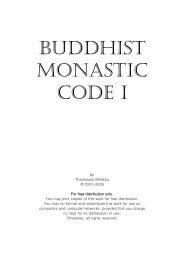Vipassana Kammatthana.pdf
Vipassana Kammatthana.pdf
Vipassana Kammatthana.pdf
Create successful ePaper yourself
Turn your PDF publications into a flip-book with our unique Google optimized e-Paper software.
whether tadåramana arise or do not arise subsequent to vipassanå javana. The vipassanå mano<br />
dvårika javana vithi mind processes are as follows:<br />
VIPASSANÓ MANODVÓRIKAJAVANAVÁTHI<br />
manodvåravajana (1)<br />
javana<br />
(7)<br />
sahetuka tadåra<br />
mmaˆa (2)<br />
/ahetuka tadåra<br />
mmaˆa (2)<br />
accompanied with ñåˆa and p¥ti - 12 34 34 /12/11<br />
accompanied with ñåˆa but not with p¥ti - 12 33 33 /11/11<br />
accompanied with p¥ti but not with ñåˆa - 12 33 33 /12/11<br />
not accompanied with ñåˆa and p¥ti - 12 32 32 /11/11<br />
Take note that the whole manodvårikajavana v¥thi mind process together with the accompa<br />
nying metal factors (cetasikas) are called as:<br />
1.<br />
the mind which is meditating as anicca; the mind meditating as dukkha; the mind med<br />
itating as anatta.<br />
2. the 1st mind, 2nd mind etc.<br />
3. the previous mind, the subsequent mind, by means of ekatta method.<br />
The reason is that the object of the 1st manodvårika vipassanå mind process is the rËpa dha<br />
mma of the 7 methods; and the object of the 2nd manodvårika vipassanåjavana v¥thi is the 1st<br />
manodvårika vipassanå javana mind process = nåma dhamma. It is extremely difficult that in<br />
the javana v¥thi mind process which has only one åvajjana, one mind takes rËpa as object and<br />
another mind takes nåma as object. Therefore take note that the v¥thi which takes rËpa as obj<br />
ect is one v¥thi and the v¥thi which takes nåma as object is another v¥thi. Take note that the w<br />
hole of one v¥thi mind process is called previous mind or subsequent mind etc. by the ekatta<br />
method. Tadårammaˆa may or may not arise. If tadårammaˆa arises then it may be ahetuka ta<br />
dårammaˆa or sahetuka tadårammaˆa accordingly.<br />
2.YAMAKA = METHOD BY PAIRS<br />
After having meditated as anicca on the ådånanikkhapa rËpa, meditate vipassanå on that m<br />
editating<br />
mind by a subsequent mind as anicca, as dukkha, as anatta separately. (Note that it is simi<br />
lar for having meditated as dukkha and as anatta).<br />
Take note that the method is the same in vayovu∂∂hattha∫gama rËpa, åhåramaya rËpa, utu<br />
maya rËpa, kammaja rËpa, cittasamu håna rËpa and dhammatå rËpa. In the kalåpa method, th<br />
e rËpa in the 7 methods are meditated upon as a whole, without differentiately the method; bu<br />
t as for the yamaka method, meditate after having separated them into individual methods. Th<br />
is is the only difference. However, although it is to meditate after having separated the individ<br />
ual methods, it is necessary to meditate thoroughly in each method. This is especially so in th<br />
e vayovu ha∫gama rËpa of the rËpa sattaka; (meditate on the rËpa and then meditate on the m<br />
editating vipassanå mind thoroughly according to the divided stage of periods of life such as)<br />
meditate on the rËpa of the 1st periods of life then meditate again on the meditating insight =<br />
meditating mind; after that meditate on the rËpa of the 2nd periods of life then meditate = aga<br />
in on the meditating insight = meditating mind; etc. Understand that the way is the same for t<br />
he other rËpa.<br />
3.METHOD BY KHAÔIKA<br />
The meditator meditates on the ådånanikhepa rËpa as anicca and then;<br />
1<br />
40






